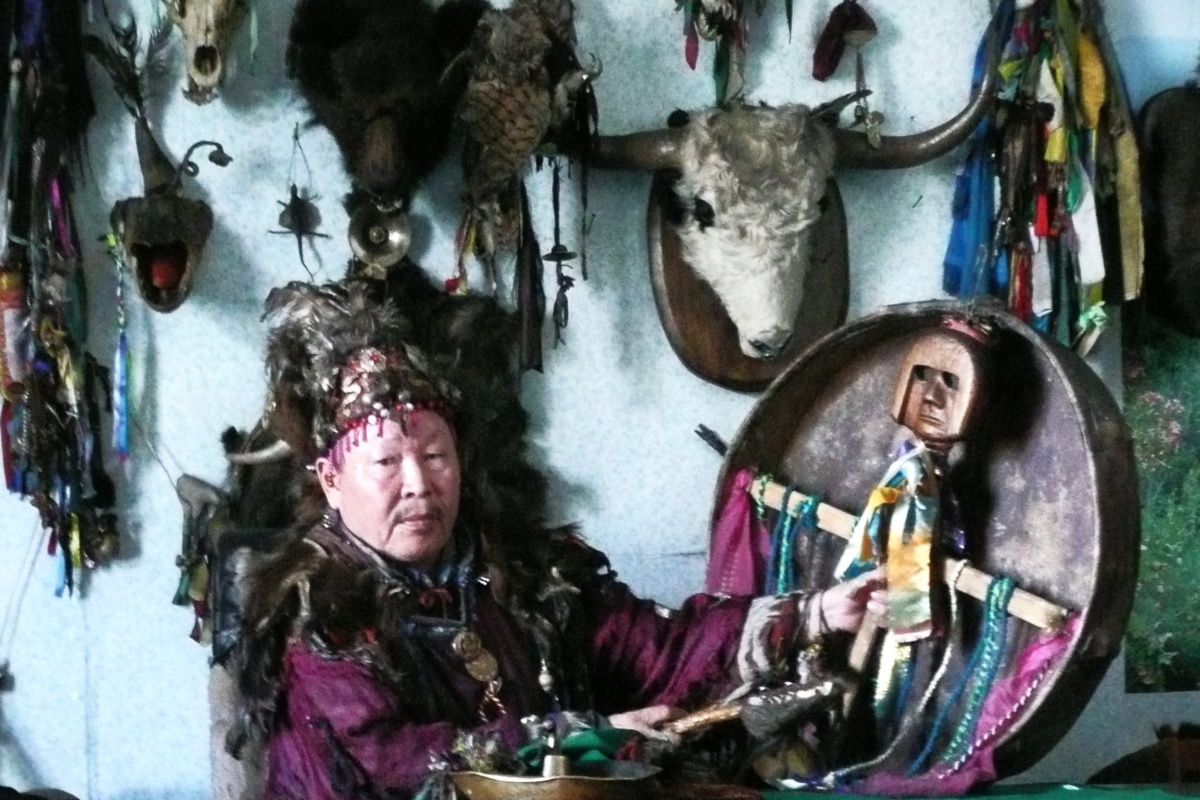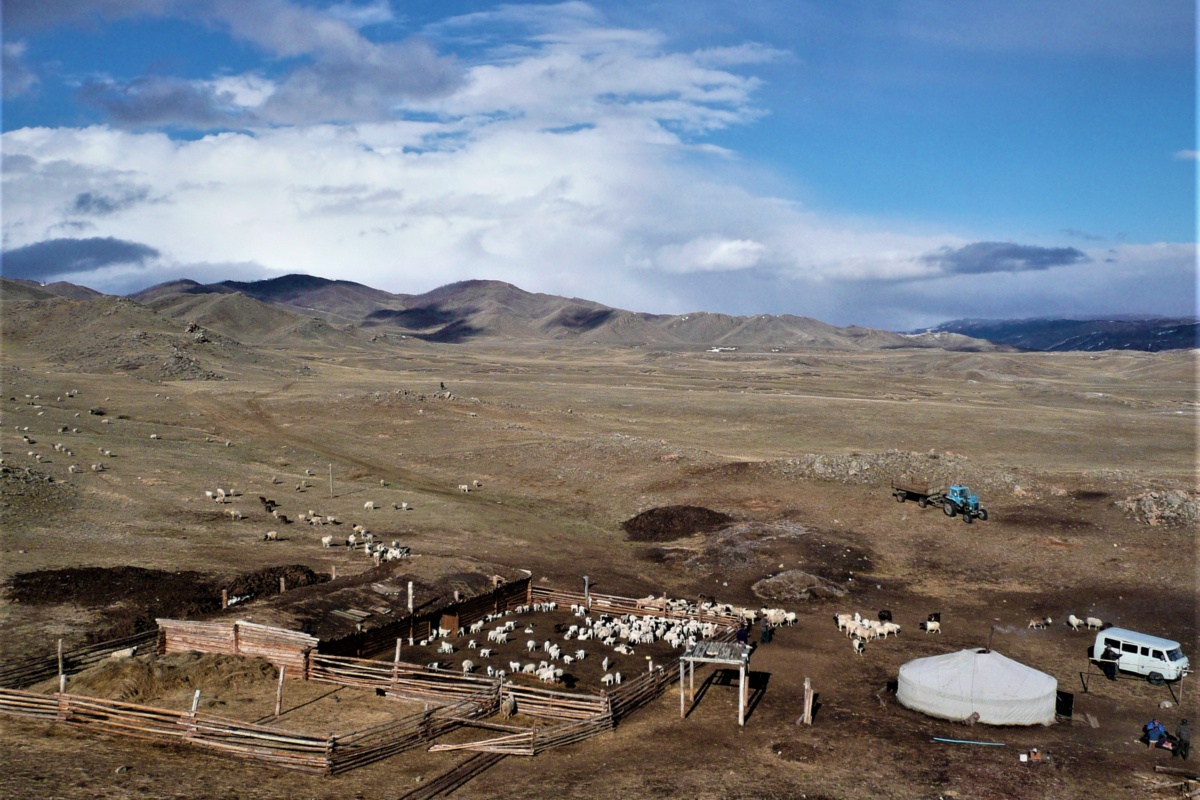[5 mins reading]
“The main task of shamans is to protect nature.”
The head shaman says, “We act for the mountain and river, taiga and all the landscapes of our homeland.”
He has put the authority of the wild on the walls of this sanctum. Three bearskins, the skulls of ox and boar, the wigs of an eagle, a bow with arrows, prayer flags, many braided ropes and beads. A snake, a squirrel, a horn.
The room is quiet, there is no hint of any other world.
A cell phone rings. One of the female shamans steps out.
Dopchun-ool Kara-ool waits a moment. Crinkles eyes.
“To be a shaman, you have to know all the voices of nature. The language of the spirits. This has been a time of bad fortune. Our hope is the renaissance of the traditional ways.”
“We are modern people, using mass media and the internet.”
This is Tuva, right at the living heart of Asia. It’s the Siberian shaman house of the Adyg-Eeren Bear Society.
The society is in a plain neighbourhood of Kyzyl, the capital on the steppe, on the southern shore of Siberia’s greatest river. In the sludgy water ice floes grind and clash. The river is grey, at the far ends of the grid of streets, the tarmac and housing giving way abruptly to grassland.
Coal smoke pours from chimneys and seems to fill the valley. A splendid river, the Yenisei, says Chekhov. It flows another three thousand kilometres to the Arctic Ocean from here.
On the shore is a white stupa. Golden spire and shining crown, prayer flags strung in lines. A concrete eagle gazes over the water to Dogee Mountain, to the world’s largest Buddhist mantra. One hundred metres and more, laid out in white stones by the Dalai Lama’s team.
It reads, Om Mani Padme Hum.
Kara-ool and forty shamans work for the revival of Tuvan traditions and culture. The room is lit by only a small window. Six masked shamans sit in a row, including Larissa Churum-oolowna and Orlanma Mongush.
Larissa’s father, grand and great-grand fathers are shamans, but she does not begin practising until thirty-eight years of age. Orlanma works in the police, hiding her shaman skills for so long like many others.
Kara-ool has been practising longer, since 1961. His grandmother was a shaman, people came to visit in the depths of night. His grandfather was a Buddhist monk who studied in Tibet. Lifetimes spent keeping knowledge from the ruling forces.
The Soviets were ruthless. They kill lamas and shamans, turns temples into rubble. The secret police take shamans in planes and push them out, saying, go on, show us you can fly. There are Siberian plans for secession, a green and white flag briefly adopted. This movement is crushed.
They’re grateful at least for their isolation.
Kara-ool holds a drum as large as a shield, the north-south beams carved with heads, the membrane representing the border between worlds. A small wooden table in the corner is crammed with figurines and cards.
He tells of the global movement of this Drum of Peace. Places of worship are everywhere in nature, in animals and hillsides, in trees and rock formations.
Now they as indigenous people are in charge. It is a wide land of nomadic herders, of sheep and horse and camel. On yurts across the steppe can be found solar panels. To charge phones and TVs of the nomad families.
This is the land of khoomei, the throat singers and their sagas. The long sound of the steppe. The longest known story is five hundred thousand lines.
Sayan Papa is a throat-singer.
He says, “We let things happen and evolve, and we don’t destroy the nomadic way of life. We put up our yurts and we haven’t harmed anything. Not the grass, not the sunlight. When we play music, we’ve taken from nature and given back to it. Everything passes through us, and in the end, we’re back to zero.”
“A big and beautiful zero.”
The Tuvan throat-singers sing this song on the steppe:
“Let my people live well, Let their work go well,
Let the children live well, Let life be without obstacles.”
Out on the land, an eagle soars faint in the thin air, far above the rippling grasslands. Over a gravel wash bubbles a stream, recently melted.
Carpets of spring flowers are turning pastures yellow and purple. A herd of heavy-headed Siberian horses grazes as a line of sheep and goats trail up a mountain slope.
At the mountain pass, watery sunlight washes the snow piled along the cleared road.
A raven caws, perches on a burned spruce. A wide area is scorched, the stumps charcoal black. Tied to its branches of a special tree are a thousand prayer flags, saturated silks of bright red and blue, green, yellow and white, many faded and wind-frayed, their prayers dispersing.
The raven ambles to another tree, attaches itself. Another arrives, and the flags crackle with intent.
A silver-tailed arctic fox runs along a ditch line.
The raven swoops, flies with the fox as it runs up scree and into the snow.
In the city, there is warm sunlight. Across the earthy yard is a cone of wood and branches. It is on a ring of stones, on top is a circular drum symbol with cross-ties of cloth.
Kara-ool says, “What does the future look like if our ways can be preserved, and the worst of the modern avoided?”
A single cloud is static on the dome of the cobalt sky, fixed to a distant shadow on hills away to the north.
Life is lived according to the way of that white cloud.
They’re grateful at least for the isolation.
The shamans stand in a circle, each wearing an animal mask. At each corner of the yard are poles topped with skulls and hanging with the pelts of wild sheep and bears.
The old world returns.
A shaman blows a horn, the fire is set in the sticks. Soon there are crackling flames, and so all lives begin to come to a quiet halt.
The sun shines hard, glittering off brass and silver and whirling drums. Spirits are invited by the drumming and fire. Smoke swirls around the yard, in and out of dancing figures.
Much time passes.
The air congeals.
The drumming stops. Time restarts.
 Jules Pretty
Jules Pretty

